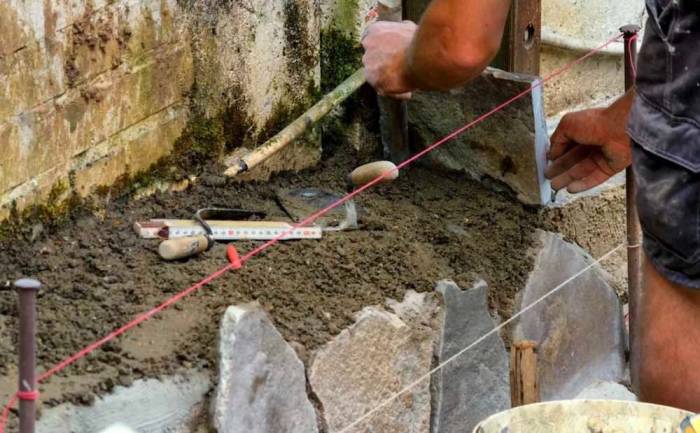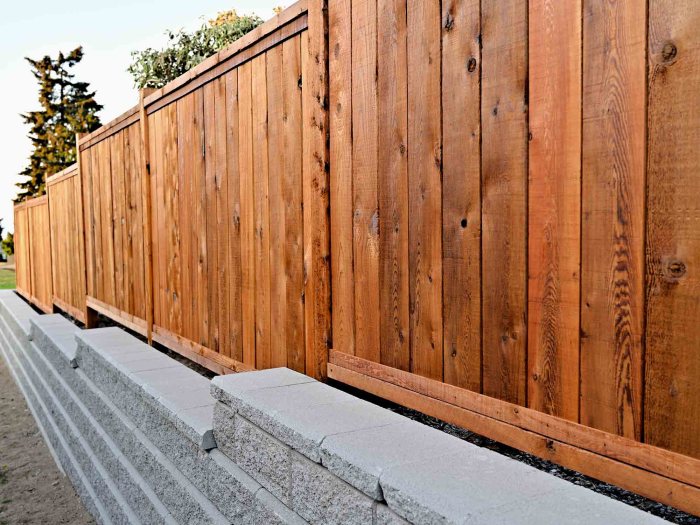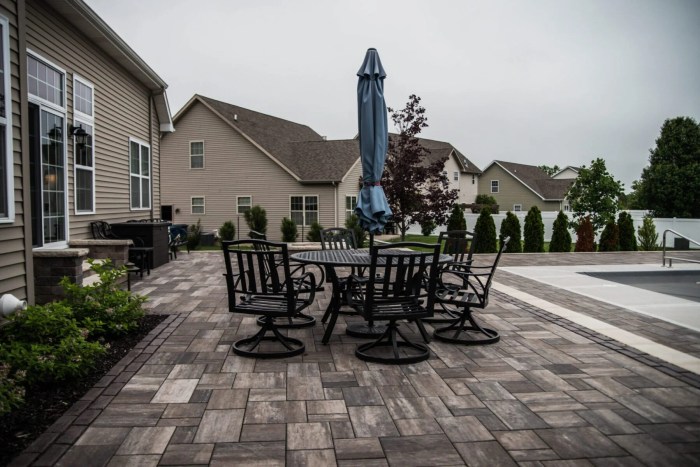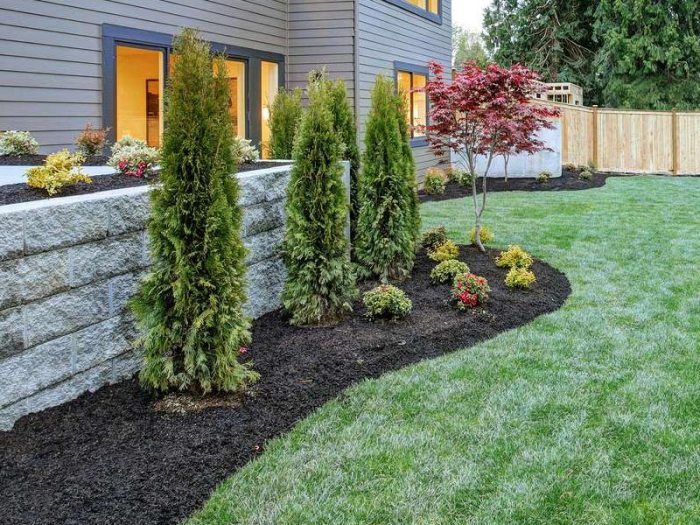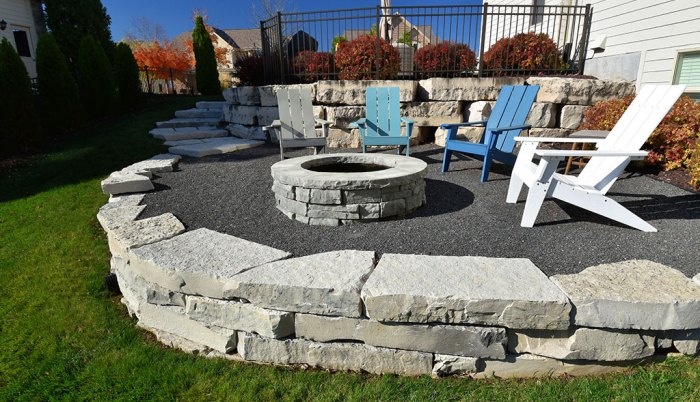Landscaping Retaining Wall Companies A Comprehensive Guide
Landscaping retaining wall companies are essential for creating beautiful and functional outdoor spaces. They offer a range of services, from initial design to final construction and maintenance. Understanding the different types of companies, their services, and the factors influencing project costs is key to making informed decisions. This guide explores the entire landscape of retaining wall companies, from local businesses to national franchises, highlighting key considerations for homeowners and businesses alike.
This guide delves into the various aspects of selecting the right landscaping retaining wall company. We examine crucial factors like company expertise, project management, financial considerations, and the importance of client communication. It also discusses future trends and innovations in the industry, offering a comprehensive perspective for those seeking to build or improve their outdoor spaces.
Introduction to Landscaping Retaining Wall Companies
Landscaping retaining walls are crucial elements in landscape design, providing support for sloped yards, creating terraces, and enhancing aesthetic appeal. The industry encompasses a wide range of companies, from small, locally-owned businesses to large national franchises, each offering specialized services and varying levels of expertise. Understanding the different types of companies and their services is key to selecting the right partner for a project.
The landscaping retaining wall industry is characterized by a diverse range of companies, each with its strengths and approaches. These companies cater to a broad spectrum of needs, from residential properties to large-scale commercial projects. The level of service, from initial design to final construction and ongoing maintenance, can vary considerably depending on the company’s size and specialization.
Types of Landscaping Retaining Wall Companies
Various types of landscaping retaining wall companies exist, each with distinct characteristics. Small local businesses often offer personalized service, tailored to specific client needs. Large national franchises typically provide standardized services across multiple locations, leveraging economies of scale. Their extensive network can offer greater resources for large-scale projects.
Services Offered by Landscaping Retaining Wall Companies
Landscaping retaining wall companies typically provide a range of services, from initial design and planning to construction and post-installation maintenance. These services can encompass site assessment, design consultation, material selection, and construction execution. A comprehensive service often includes ongoing maintenance to ensure the long-term structural integrity and aesthetic appeal of the wall. For example, regular inspections and repairs can prevent costly damage or structural failures.
Successful Retaining Wall Projects
Successful retaining wall projects often incorporate innovative design elements and high-quality materials. A notable example might be a residential project that transformed a steep hillside into a usable garden space, or a commercial project where a retaining wall system successfully managed erosion on a sloped property. The successful implementation of a retaining wall can significantly enhance the overall value and livability of a property.
Comparison of Retaining Wall Materials
| Material | Pros | Cons |
|---|---|---|
| Concrete | Durable, strong, versatile, and can be customized with various finishes. | It can be heavy, requires significant excavation, and may not always match the aesthetic of the surrounding landscape. |
| Stone (Natural Stone) | Aesthetically pleasing, durable, and offers a natural, timeless look. Often a good choice for integrating with existing landscape elements. | It can be expensive, requires careful selection and placement, and might need specialized installation techniques. |
| Wood | Relatively affordable, relatively easy to install, and available in various styles. | Susceptible to rot and decay, requires regular maintenance, and is generally less durable than concrete or stone. |
The table above provides a concise comparison of common retaining wall materials. Choosing the right material depends on factors like budget, desired aesthetic, and the specific needs of the project.
Identifying Key Players in the Industry
Understanding the landscape of retaining wall companies is crucial for both potential clients and competitors alike. This section details prominent players in a specific geographic area, analyzes factors contributing to their success, and explores variations in their pricing and expertise. Recognizing these elements provides a more complete picture of the industry’s dynamics.
Prominent Landscaping Retaining Wall Companies
Several established and emerging landscaping retaining wall companies dominate the market within the specified geographic area. These companies often specialize in different aspects of retaining wall construction, from design and installation to maintenance and repair. Their presence and influence vary depending on factors like local demand, market saturation, and competitive strategies.
Factors Contributing to Company Success
Several key factors contribute to the success of retaining wall companies. Strong project management, a skilled workforce, a robust client base, and positive online reviews are crucial. Effective communication, a commitment to quality materials, and competitive pricing are also important for attracting and retaining clients. Finally, a company’s reputation for reliability and dependability within the local community plays a vital role in its long-term success.
Pricing Models Used by Different Companies
Pricing models vary significantly among retaining wall companies. Some companies use a fixed-price model for projects of a specific scope and complexity, while others employ an hourly rate or a combination of both. Project-based pricing can be attractive for clients with clearly defined needs, whereas hourly rates might suit situations requiring flexibility. Variations in pricing are often attributed to factors like material costs, labor rates, and project complexity.
Expertise and Experience Levels of Employees
The expertise and experience of employees directly impact a company’s quality of work and client satisfaction. Companies with experienced designers can create innovative and aesthetically pleasing retaining wall solutions. Construction crews with extensive experience can ensure efficient and accurate installation. Additionally, knowledgeable staff regarding local building codes and regulations is essential to ensure compliance.
Company Profiles and Geographic Coverage
| Company Name | Specialization | Geographic Coverage |
|---|---|---|
| Apex Retaining Walls | Design and construction of complex retaining walls, including custom designs and use of specialized materials. | Covers the northern and central regions of the specified area. |
| Terraform Solutions | Installation of standard retaining walls with a focus on cost-effectiveness. | Services the entire geographic area, with a higher concentration in the southern region. |
| Stone Masters | Expert in natural stone retaining walls, offering a unique aesthetic and durability. | Focuses on high-end residential and commercial projects in the western portion of the area. |
| Wallcraft | Comprehensive retaining wall solutions, including design, installation, and maintenance. | Operates across the entire geographic region. |
Evaluating Company Services and Expertise
Selecting the right landscaping retaining wall company hinges on evaluating their design process, expertise in various wall types, and adherence to crucial construction and safety standards. Understanding their approach to drainage, permits, and project timelines is vital for a successful outcome. A well-structured process, from initial consultation to completion, ensures the project meets expectations and adheres to local regulations.
Design Process for Retaining Walls
The design process for retaining walls involves careful consideration of site conditions, soil stability, and aesthetic goals. A thorough site assessment is crucial to determine the optimal retaining wall design, considering factors such as slope angle, soil type, water table, and existing vegetation. Engineers and designers utilize specialized software and techniques to model the wall’s performance under various loading conditions, ensuring stability and safety. This process includes detailed calculations, material selection, and cost estimations.
Types of Retaining Wall Designs
Various retaining wall designs cater to diverse site conditions and aesthetic preferences. Common types include gravity walls, cantilever walls, and anchored walls. Gravity walls rely on their weight for stability, suitable for relatively stable soil conditions. Cantilever walls utilize a reinforced concrete base and a projecting stem for support, offering more stability in challenging soil conditions. Anchored walls employ steel or other materials to counteract the lateral pressure exerted on the wall, commonly used in steep slopes or unstable soil. Each design type has specific advantages and limitations, and the appropriate choice depends on the specific site characteristics and budget.
Construction Methods for Different Retaining Wall Types
Construction methods for retaining walls vary based on the chosen design. Gravity walls typically involve the construction of large, solid blocks or poured concrete. Cantilever walls necessitate precise concrete pouring and reinforcement bar placement. Anchored walls require the installation of anchors into the ground, potentially involving excavation and specialized equipment. The chosen method directly impacts the timeline, cost, and overall project complexity. Proper construction techniques are essential to ensure the wall’s structural integrity and longevity.
Importance of Proper Drainage Systems in Retaining Wall Projects
Adequate drainage is critical for the long-term success of any retaining wall project. Water accumulation behind the wall can lead to soil erosion, pressure buildup, and potential structural damage. A well-designed drainage system, incorporating weep holes, French drains, or other methods, prevents water from accumulating behind the wall, ensuring stability and preventing water damage to the surrounding landscape.
Role of Permits and Regulations in Retaining Wall Installations
Obtaining the necessary permits and adhering to local regulations is essential for any retaining wall installation. These regulations often address setback requirements, building codes, and environmental considerations. Failure to comply with these regulations can result in costly delays, project setbacks, or even project termination. It is crucial to consult with local authorities and obtain all required permits before commencing any construction.
Typical Steps in a Retaining Wall Project
| Step | Description |
|---|---|
| 1. Initial Consultation | Site assessment, client needs evaluation, and preliminary design concepts. |
| 2. Design & Planning | Detailed design drawings, material specifications, cost estimates, and permit applications. |
| 3. Permitting & Approvals | Obtaining necessary permits from local authorities, adhering to regulations. |
| 4. Excavation & Site Preparation | Digging the foundation, preparing the site for wall construction. |
| 5. Construction | Building the retaining wall, ensuring proper placement and materials. |
| 6. Backfilling & Landscaping | Refilling the excavated area and completing the landscaping around the wall. |
| 7. Final Inspection & Completion | Final inspections and acceptance by local authorities, and project completion. |
Client Needs and Project Requirements: Landscaping Retaining Wall Companies
Choosing the right retaining wall company hinges on understanding client needs and project specifics. A thorough understanding of these elements allows for a tailored solution that meets client expectations and project goals. This section delves into common client needs, crucial factors for company selection, and cost considerations for retaining wall projects.
Common Client Needs and Expectations
Clients often prioritize aesthetic appeal, stability, and functionality in retaining wall projects. They expect a visually pleasing addition that complements the surrounding landscape, while also providing long-term structural integrity. Many clients seek retaining walls that enhance property value and contribute to the overall curb appeal. Practicality, such as ease of maintenance and accessibility, is also frequently important.
Factors to Consider When Choosing a Retaining Wall Company
Several factors are vital when selecting a retaining wall contractor. Experience and expertise in retaining wall construction are paramount. A company’s portfolio and past projects offer valuable insights into its capabilities. The company’s reputation and client testimonials provide an understanding of their work ethic and customer service. Financial stability and insurance coverage are also crucial considerations. A well-established company with a proven track record is likely to provide a more reliable and sustainable solution.
Factors Influencing the Cost of Retaining Wall Projects
The cost of retaining wall projects is influenced by several key factors. The size and complexity of the project significantly impact the overall cost. The type of materials used, such as concrete, stone, or composite materials, will also affect the budget. Labor costs and any additional site preparation or excavation work will contribute to the project’s total expense. Professional design and engineering services may add to the project’s cost. Ultimately, a comprehensive cost estimate should consider all project elements.
Examples of Different Retaining Wall Projects
Residential retaining walls are often used to create tiered gardens, improve yard space, and define property boundaries. Commercial retaining walls might be integral to slope stabilization for parking lots, roadways, or building foundations. Examples include large-scale projects at construction sites or smaller, aesthetically pleasing retaining walls at retail stores or restaurants.
Importance of Site Assessments in Retaining Wall Projects
Thorough site assessments are critical for successful retaining wall projects. A comprehensive site evaluation considers factors such as soil conditions, slope stability, and existing infrastructure. This evaluation is essential for determining the appropriate design and material choices for the project. An accurate assessment helps in minimizing potential risks and ensuring long-term stability.
Key Considerations for Choosing a Retaining Wall Company
| Criteria | Explanation |
|---|---|
| Experience | A company with a proven track record of successful retaining wall projects is more likely to deliver quality work. |
| Cost | Compare quotes from multiple companies, considering not only the initial price but also potential hidden costs and long-term maintenance. |
| Reputation | Client testimonials and online reviews can provide valuable insights into a company’s reliability and customer service. |
| Materials | The quality and durability of the materials used in construction can impact the long-term performance of the wall. |
| Permitting and Regulations | Understanding local building codes and regulations is essential to avoid costly delays or project setbacks. |
Project Management and Execution
Project management for retaining wall installations is a crucial aspect of delivering successful and lasting projects. Effective project management ensures that the project adheres to the agreed-upon budget, timeline, and quality standards. This involves meticulous planning, skilled execution, and proactive communication throughout the entire process.
Project management for retaining wall installations involves a phased approach. From initial site assessment and design to final inspection and client handover, each phase requires careful consideration and coordination to ensure a smooth and efficient process. The project manager plays a vital role in keeping all stakeholders informed and aligned on the project’s progress.
Project Management Process
A well-defined project management process ensures that retaining wall installations are executed efficiently and effectively. This involves detailed planning, precise material procurement, and careful scheduling of installation activities. Clear communication channels between the company and the client are critical to address any concerns or changes promptly.
Importance of Client Communication, Landscaping, and Retaining Wall Companies
Open and consistent communication is essential for a successful retaining wall project. This includes regular updates on project progress, proactive responses to client inquiries, and clear communication regarding potential delays or adjustments to the project plan. Transparent communication fosters trust and collaboration, leading to a positive client experience.
Quality Control in Retaining Wall Projects
Quality control is paramount in retaining wall projects to ensure structural integrity and longevity. This involves rigorous adherence to industry standards, the use of high-quality materials, and meticulous craftsmanship throughout the installation process. Regular inspections and quality checks at various stages of the project are crucial to identify and address potential issues promptly.
Managing Potential Project Challenges
Unexpected challenges are inevitable in construction projects. A proactive approach to anticipate and mitigate potential issues is vital. This involves developing contingency plans for weather delays, material shortages, or unforeseen ground conditions. Adaptability and a flexible approach to problem-solving are key to navigating these challenges effectively.
Ensuring Timely Project Completion
Adhering to the agreed-upon project timeline is critical for maintaining client satisfaction. Effective scheduling, efficient workforce management, and proactive communication regarding potential delays are essential for timely project completion. This involves establishing realistic timelines, considering potential factors that could impact the schedule, and maintaining clear communication channels.
Potential Challenges and Solutions
| Potential Challenges | Solutions |
|---|---|
| Unforeseen ground conditions (e.g., rock, unstable soil) | Employ geotechnical assessments, adjust design plans as needed, and utilize appropriate reinforcement techniques. |
| Material shortages or delays | Maintain a robust supply chain, explore alternative materials, and develop contingency plans for procuring materials. |
| Weather-related delays | Monitor weather forecasts, schedule work around adverse conditions, and have backup plans for inclement weather. |
| Difficulties in obtaining necessary permits | Establish a strong relationship with local authorities, stay informed about regulations, and anticipate potential permit-related issues. |
| Unexpected site conditions that affect the project scope | Thorough site surveys and pre-project consultations, with clear communication and agreements with the client on any scope adjustments. |
Financial Aspects and Pricing Models
The financial aspects of retaining wall projects are crucial for both clients and contractors. Understanding the factors influencing costs and the various pricing models employed is vital for a successful and transparent project. This section delves into the details of these aspects, offering clarity and insight into the financial landscape of retaining wall construction.
Factors Determining Retaining Wall Costs
Several factors influence the final cost of a retaining wall project. These include the size and complexity of the wall, the materials chosen, the site conditions, and the labor required. The extent of excavation, the need for specialized equipment, and the presence of any unforeseen challenges during construction also contribute to the overall project cost.
Pricing Models Used by Retaining Wall Companies
Retaining wall companies often employ various pricing models to structure their bids. These models typically fall into fixed-price contracts, time-and-materials contracts, and unit pricing. Fixed-price contracts offer a clear, upfront cost, while time-and-materials contracts allow for adjustments based on actual project duration and materials used. Unit pricing structures pricing based on the quantities of materials and labor used.
Potential Costs Associated with Materials, Labor, and Permits
Materials costs vary significantly depending on the chosen materials. Concrete, stone, or composite materials, for instance, will have different price points. Labor costs are influenced by the complexity of the project, the geographical location, and the contractor’s experience. Permitting costs, while often underestimated, can vary greatly based on local regulations and the specific project requirements. Thorough pre-construction site assessments are crucial to estimating these costs accurately.
Examples of Project Cost Breakdowns for Retaining Walls
A 10-foot-high, 20-foot-long retaining wall constructed of poured concrete might cost approximately $15,000 to $25,000, including materials, labor, and permitting. This range accounts for variations in site conditions, material availability, and labor costs. A smaller, simpler retaining wall using natural stone might cost considerably less, in the $5,000 to $10,000 range.
Table of Pricing Models
| Pricing Model | Description | Pros | Cons |
|---|---|---|---|
| Fixed-Price Contract | A predetermined price for the entire project. | Clear upfront cost; easier budgeting for clients. | Potential for cost overruns if unforeseen issues arise; less flexibility. |
| Time-and-Materials Contract | Cost is based on the actual time spent and materials used. | Flexibility to adapt to unexpected issues; transparent cost tracking. | Potentially higher final cost if the project takes longer than anticipated; less clarity upfront. |
| Unit Pricing | Cost is determined by the quantity of materials and labor used. | Transparent pricing based on specific project elements. | Complex to estimate total costs; may not cover unforeseen circumstances. |
Customer Reviews and Reputation Management
Customer reviews are a powerful tool for retaining wall companies to build trust and attract new clients. Positive reviews act as social proof, validating the quality of work and service. Conversely, negative reviews, if addressed effectively, can be valuable learning opportunities. Understanding how to analyze and respond to customer feedback is crucial for maintaining a strong online presence and reputation.
Importance of Customer Reviews
Customer reviews provide valuable insights into the client experience. They reflect the company’s strengths and weaknesses, allowing for targeted improvements in service quality and operational efficiency. Positive feedback reinforces the company’s commitment to excellence, while constructive criticism, when addressed appropriately, can lead to long-term improvements. By actively managing online reviews, companies can foster customer loyalty and encourage repeat business.
Analyzing Customer Reviews for Improvement
A thorough review analysis requires careful consideration of both positive and negative feedback. Companies should identify recurring themes in the reviews. Are clients consistently praising the craftsmanship? Or are there recurring complaints about project timelines or communication? By categorizing feedback, companies can pinpoint areas needing attention and develop strategies for improvement. This allows for more proactive problem-solving and better client service.
Using Reviews to Enhance Reputation
Companies can leverage customer reviews to enhance their online reputation by actively responding to both positive and negative feedback. A thoughtful response to a positive review can express appreciation and reinforce the company’s values. Addressing negative reviews constructively demonstrates a commitment to client satisfaction and a willingness to resolve issues. Responding to reviews in a timely and professional manner can turn potential negative experiences into opportunities for building trust.
Role of Online Reviews in Attracting Clients
Potential clients often rely on online reviews to gauge the credibility and reliability of a retaining wall company. Positive reviews can build trust and increase the likelihood of a potential client choosing a company with a strong reputation. High ratings and positive testimonials act as social proof, indicating a company’s expertise and commitment to quality work. A company with a consistent pattern of positive reviews is more likely to attract new clients.
Sample Customer Review Analysis
| Review Category | Positive Feedback Examples | Negative Feedback Examples | Actionable Insights |
|---|---|---|---|
| Project Management | “Excellent communication throughout the project.” “The project manager was very responsive.” | “The project timeline was longer than expected.” “Lack of communication during the project.” | Improve project planning and communication processes. Ensure clear communication with clients regarding project timelines. |
| Quality of Workmanship | “The retaining wall is beautiful and well-built.” “Excellent craftsmanship.” | “The wall is uneven in places.” “Materials used were not as described.” | Verify quality control measures and ensure consistent adherence to standards. Review material specifications with clients. |
| Customer Service | “The team was friendly and helpful.” “Great customer service throughout the entire process.” | “The customer service was slow to respond.” “The staff was not very helpful.” | Enhance customer service training and response time. Encourage proactive communication. |
Future Trends and Innovations
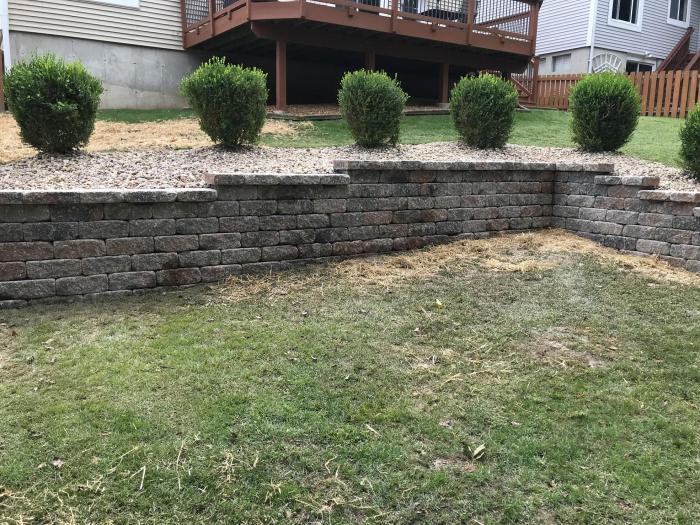
Source: bigbendlandscaping.com
The landscaping retaining wall industry is constantly evolving, driven by advancements in materials, construction techniques, and technological integration. Understanding these emerging trends is crucial for businesses to adapt and remain competitive, anticipating client needs and delivering innovative solutions.
Emerging Trends in Retaining Wall Design
Modern retaining wall designs are moving beyond traditional styles, incorporating aesthetic elements and functional enhancements. Sustainability is a key driver, with designs prioritizing water management, erosion control, and minimal environmental impact. Bioretention systems, integrated with retaining walls, are gaining popularity, helping manage stormwater runoff and create healthier ecosystems.
Innovative Materials and Techniques
The use of innovative materials and techniques is transforming retaining wall construction. Composite materials, offering a balance of strength and aesthetics, are becoming more prevalent. Prefabricated wall systems, often constructed in modular units, are streamlining the installation process and reducing construction time. These systems frequently use sustainable materials like recycled plastic or engineered wood, aligning with eco-conscious design principles. Geosynthetic materials, such as geotextiles and geogrids, are also playing an increasingly important role in enhancing soil stabilization and preventing erosion behind retaining walls.
Impact of Technology on the Retaining Wall Industry
Technology is rapidly influencing the retaining wall industry, from design and planning to construction and maintenance. 3D modeling software allows for precise design visualization, enabling clients to see the final product before construction. Building Information Modeling (BIM) is becoming more integrated into the design process, facilitating better coordination among project stakeholders and reducing potential errors. Furthermore, drone technology is enabling more efficient site surveys and inspections, allowing for quicker assessment and faster problem-solving.
Future Demand for Landscaping Retaining Wall Services
The demand for landscaping retaining walls is expected to remain robust, fueled by the growing popularity of outdoor living spaces and the need for enhanced property value. As populations continue to concentrate in urban areas, there is a heightened demand for creative and functional solutions for residential and commercial landscapes. This trend is further reinforced by an increasing awareness of the importance of sustainable landscaping practices. Property owners are seeking ways to enhance their properties while minimizing their environmental footprint.
Forecasted Growth and Innovation in Retaining Wall Design (Next 5 Years)
| Year | Trend | Innovation | Impact |
|---|---|---|---|
| 2024 | Increased use of composite materials | Development of lighter, more durable composite materials | Reduced construction time and cost; enhanced aesthetics |
| 2025 | Integration of smart technologies | Implementation of sensors for moisture monitoring and automated irrigation systems | Enhanced sustainability and efficient water management |
| 2026 | Rise of bioretention systems | Development of advanced bioretention solutions integrated with retaining walls | Improved water quality and environmental benefits |
| 2027 | Focus on sustainable materials | Wider use of reclaimed and recycled materials | Increased eco-friendliness and reduced environmental impact |
| 2028 | Growing use of 3D modeling | Advancements in 3D modeling software for accurate design and visualization | Improved project planning, reduced errors, and enhanced client satisfaction |
Last Word
In conclusion, choosing the right landscaping retaining wall company requires careful consideration of various factors, including their expertise, project management approach, and financial aspects. By understanding the services offered, the different types of companies, and the client’s needs, you can make an informed decision. This comprehensive guide provides a roadmap for selecting the ideal partner to transform your outdoor space. The future of retaining walls promises exciting innovations, driven by technology and a growing demand for these essential landscape features.
